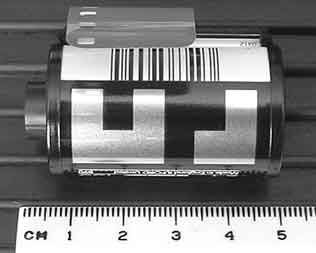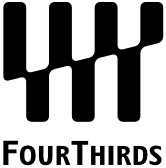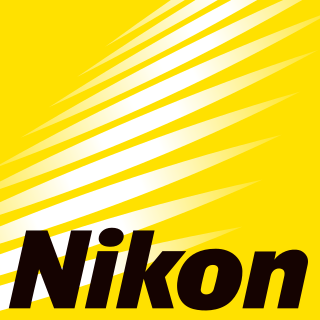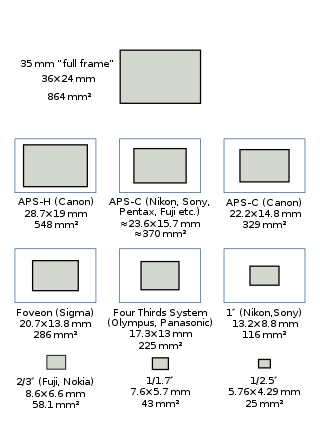The following list comprises significant milestones in the development of photography technology.

Advanced Photo System (APS) is a discontinued film format for still photography first produced in 1996. It was marketed by Eastman Kodak under the brand name Advantix, by FujiFilm under the name Nexia, by Agfa under the name Futura and by Konica as Centuria.

DX encoding is an ANSI and I3A standard, originally introduced by Kodak in March 1983, for marking 135 and APS photographic film and film cartridges. It consists of several parts, a latent image DX film edge barcode on the film below the sprocket holes, a code on the cartridge used by automatic cameras, and a barcode on the cartridge read by photo-finishing machines.

The Four Thirds System is a standard created by Olympus and Eastman Kodak for digital single-lens reflex camera (DSLR) design and development. Four Thirds refers to both the size of the image sensor (4/3") as well as the aspect ratio (4:3). The Olympus E-1 was the first Four Thirds DSLR, announced and released in 2003. In 2008, Olympus and Panasonic began publicizing the Micro Four Thirds system, a mirrorless camera system which used the same sensor size; by eliminating the reflex mirror, the Micro Four Thirds cameras were significantly smaller than the Four Thirds cameras. The first Micro Four Thirds cameras were released in 2009 and the final Four Thirds cameras were released in 2010; by that time, approximately 15 Four Thirds camera models had been released by Olympus and Panasonic in total. The Four Thirds system was quietly discontinued in 2017, six years after the final cameras were released.

Nikon Corporation is a Japanese optics and photographic equipment manufacturer headquartered in Tokyo, Japan. The companies held by Nikon form the Nikon Group.

A digital single-lens reflex camera is a digital camera that combines the optics and mechanisms of a single-lens reflex camera with a solid-state image sensor and digitally records the images from the sensor.

The Nikon D1 is a digital single-lens reflex camera (DSLR) that was made by Nikon Corporation introduced on June 15, 1999. It features a 2.7-megapixel image sensor, 4.5-frames-per-second continuous shooting, and accepts the full range of Nikon F-mount lenses. The camera body strongly resembles the F5 and has the same general layout of controls, allowing users of Nikon film SLR cameras to quickly become proficient in using the camera. Autofocus speed on the D1 series bodies is extremely fast, even with "screw-driven" AF lenses.

Kodak EasyShare was a sub-brand of Eastman Kodak Company products identifying a consumer photography system of digital cameras, snapshot thermal printers, snapshot thermal printer docks, all-in-one inkjet printers, accessories, camera docks, software, and online print services. The brand was introduced in 2001, and discontinued in 2012, when Kodak stopped manufacturing and selling all digital cameras and photo frames.

A full-frame DSLR is a digital single-lens reflex camera (DSLR) with a 35 mm image sensor format. Historically, 35 mm was one of the standard film formats, alongside larger ones, such as medium format and large format. The full-frame DSLR is in contrast to full-frame mirrorless interchangeable-lens cameras, and DSLR and mirrorless cameras with smaller sensors, much smaller than a full 35 mm frame. Many digital cameras, both compact and SLR models, use a smaller-than-35 mm frame as it is easier and cheaper to manufacture imaging sensors at a smaller size. Historically, the earliest digital SLR models, such as the Nikon NASA F4 or Kodak DCS 100, also used a smaller sensor.

The Kodak C330 is a model of digital camera produced by the Eastman Kodak Company. It was announced on May 4, 2005 and is part of the company's EasyShare consumer line of cameras.

The Kodak EasyShare DX4530 is a digital camera made by Kodak, announced on Aug 5, 2003. Part of the DX Series of Kodak's EasyShare brand, its features include a 3x optical zoom and 10x zoom overall. The camera features a 5 megapixel CCD detector and supports six modes of operation: "sport" for use when the target is in motion, "night" for use in low light levels, "landscape" for use with distant scenery, "close up" for objects closer than 28 inches away, "auto" for general use, and "video" used to capture motion and sound.

The Kodak DX7590 is a now-discontinued point and shoot model of digital camera first introduced in November 2004, replacing the earlier DX6490. It was manufactured by Eastman Kodak as part of the Kodak EasyShare product line's DX series.
Digital Photography Review, also known as DPReview, is a website about digital cameras and digital photography, established in November 1998. The website provides comprehensive reviews of digital cameras, lenses and accessories, buying guides, user reviews, and forums for individual cameras, as well as general photography forums. The website also has a database with information about individual digital cameras, lenses, printers and imaging applications. Originally based in London, Digital Photography Review and most of its team relocated to Seattle, Washington, in 2010. It was owned by Amazon from 2007 to 2023.

DxO Labs is a privately owned photography software company. It was founded in 2003 by Jérôme Ménière, former CEO of Vision-IQ. The company's headquarters are in Paris, France.

The Kodak Digital Camera System is a series of digital single-lens reflex cameras and digital camera backs that were released by Kodak in the 1990s and 2000s, and discontinued in 2005. They are all based on existing 35mm film SLRs from Nikon, Canon and Sigma. The range includes the original Kodak DCS, the first commercially available digital SLR.

The Pentax K-5 II is a 16.3-megapixel digital single-lens reflex camera, successor to the Pentax K-5, sharing its body shape with its two predecessors including the Pentax K-7, and making incremental improvements on the K-5.

DigitaOS was a short lived digital camera operating system created by Flashpoint Technology and used on various Kodak, Pentax, and HP cameras in the late 1990s. DigitaOS debuted with the Kodak DC220 on 20 May 1998, and was released on a total of 11 camera models before it was abandoned in 2001. DigitaOS was notable for its ability to run third-party software, a concept that was not again realized until the release of various Android based digital cameras in the early 2010s.

The Nikon Z fc, announced on 29 June 2021 and released in July 2021, is a mirrorless interchangeable-lens camera with the Nikon Z-mount with a MSRP of $960 body only, in the US.
















